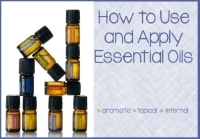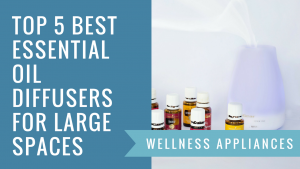Contents
Knowing how to use essential oils safely can be hard when first starting out (and learning new methods can be hard for experienced users as well!)
This guide is intended as an overview on how to use essential oils. Different methods for use, and how to do them safely.
How to Use a Diffuser
There are 4 important components which you’ll need to be accessing quite regularly to use a diffuser properly, these include: where you place the diffuser, the amount of water you use, the essential oils themselves, and the cleansing process.
Diffusers are usually best used in larger, open spaces but remember that you will need a power outlet for the energy source.
Filling up the diffuser is next, and all you will have to do is fill up the product with water as required. There is usually a fill line or instructions in the manual.
Once you’ve filled in the water, add in 3 to 10 drops of the oil you want to use. Remember: more oil causes the scent to be stronger.
Lastly, cleaning your diffuser regularly is a good idea. You can clean it by throwing out the old water, brushing the sides with a given brush or one of your own, and refilling the water.
Can you Put Essential Oils in a Humidifier
Generally no. There are a few humidifiers that will take essential oils, but the majority of humidifiers are built with only water usage in mind. For more, see our article on humidifiers vs. diffusers.
The main reasons to not put essential oils in a humidifier is because of:
- How the oils react in the machine
- How the machine reacts to having the oils
Since humidifiers are usually operated by evaporation and heat, this can actually change the oils’ properties. Due to this issue, the oils’ beneficial properties are become pointless unless you are using a cold air humidifier.
However, humidifiers often react negatively to having essential oils in its system such as coating the tank or leaving excess particles which were too large to be absorbed.
In the long run, you will need to change your humidifier often if you choose to put the oils in them.
Using Essential Oils Safely
- Ensure that the essential oil you are considering is the most effective solution to your issue. Otherwise, consult alternatives.
- Ensure that you are not allergic or sensitive to any of the oils you plan on using.
- Only use pet-safe oils for your pets.
- Think about the other people in the room and how are they going to affected when using a diffuser.
- Watch the expiration date for essential oils and refrigerate to increase longevity.
- Always store pure essential oils where children and pets cannot access them
- Stay out of the sun or tanning booth for up to 24-hours after using photosensitive oils
- It’s recommended not to use the same oils daily for weeks on end
- Use caution when using essential oils around those who have previously not been exposed to them
- Unless specified, never use full-strength essential oils directly on skin
- If using on skin for the first time, do a patch test first to test for any adverse effects
- Check safety information for oils you plan to use
- Never ever put essential oils near or into the eyes
Special Note: Olbas oil is not safe to use in the eye and can cause cornea burns and blindness - Never ingest essential oils unless you have expert advice or knowledge to do so
- Have good ventilation when using essential oils
- Always consult a healthcare professional when using essential oils around women who are pregnant
- Keep essential oils away from extreme heat sources such as flames, fire, candles, cigarettes, gas stoves, fireplaces as they are extremely combustible
How to Use Essential Oils (Methods for Using)
There are a couple different ways to use essential oils. They can be used aromatically, topically (on the skin), some can be ingested (internally), and some are used as household products (externally).
-
Use an Essential Oil Diffuser or Simply Breathe (Aromatically)
 Aromatics have been used for thousands of years, and diffusers are very prevalent in today’s society. Nothing is new under the sun, only maybe only the method for using has changed.
Aromatics have been used for thousands of years, and diffusers are very prevalent in today’s society. Nothing is new under the sun, only maybe only the method for using has changed.Using essential oils aromatically taps into the olfactory system (smelling through the nose) in the brain and certain fragrances remind us of days past—maybe we smelled lily of the valley flowers or a rose that reminded us of grandma. Aromatic fragrances can bring back those experiences.
Aromatherapy can help open the sinus cavities. Oil of cloves will help a slight tooth ache go away in the full strength form. Essential oils can relive tension and improve air quality in the home or office. The immune system can be improved with specific oils. They uplift our mood when we feel down.
Choose a good diffuser to cool the room temperature to purify the air
Inhale it directly by holding the bottle a few inches below your nose or
Put a few drops on a handkerchief and inhale it that way
Make a steam tent by putting a few drops of oil into boiling water, put your head close to the stream without burning yourself, with a towel on top of your head (tent) to keep the steam inAromatics smell good, are safe to use, and many are in perfumes and body soaps.
-
Apply to the Skin Topically
 If you have not done a skin test for sensitivity with your dermatologist or allergist, be cautious. These oils are potent and are probably sensitive to the sun (photoallergic, photosensitivity) where the compounds can be exaggerated with the sun’s UV rays. Dilute the oil to try it, but stay indoors. You can attempt a patch test with a diluted solution, but it’s best if done by a physician mentioned above.
If you have not done a skin test for sensitivity with your dermatologist or allergist, be cautious. These oils are potent and are probably sensitive to the sun (photoallergic, photosensitivity) where the compounds can be exaggerated with the sun’s UV rays. Dilute the oil to try it, but stay indoors. You can attempt a patch test with a diluted solution, but it’s best if done by a physician mentioned above.Footbaths and tub baths are wonderful with Epsom salts; it is beneficial as well. Enjoy a massage with diluted essential oils mixed with mineral oil. You can also try hot or cold compresses by putting diluted oils in a basin of water and applying with a washcloth rung out.
-
Use in a Recipe or Other Internal Uses
 Be sure to use only food type oils for consuming. You can use oregano in leaf or ground form in Italian dishes. The oil would need to be diluted greatly. Adding a drop of one of the mints with or without lemon in a glass of cold water or a cup of hot water to be a tea has benefits.
Be sure to use only food type oils for consuming. You can use oregano in leaf or ground form in Italian dishes. The oil would need to be diluted greatly. Adding a drop of one of the mints with or without lemon in a glass of cold water or a cup of hot water to be a tea has benefits.Do not use in your rectum or vagina. These areas must be evaluated by your professional healthcare provider. You can burn yourself, cause blisters, rashes, and bleeding—then you will need to see your doctor.
-
Use in a Bath or Aromatherapy massage
Add some great smelling oils to your clothes washer rinse cycle. Add it to a cup of water before pouring in directly on your clothes. After washing dishes, add essential oils to the clean sink to disinfect and leave a great fragrance afterwards. Lemon oil makes a great furniture polish and removes stains. Use a half cup of apple cider vinegar to a quart of water for your hair rather than conditioner to remove all soap film and give it a glistening shine. Do not rinse it out—the smell will go away in a few minutes. Most essential oils are antiviral or antifungal. Do not add to household paint—it will affect the paint chemical components and might not stick to surfaces.
Our discussion has been an overview for using essential oils. Use them wisely and keep your safety in mind for strong oils, especially on your skin. Good judgment is the best way to go. When you use a great diffuser with essential aromatic oils, you will be pleasantly delighted with the outcome.
How to Use Essential Oils on Skin
Using Essential oils on skin should be done carefully. Spot test before applying a lot. Generally it’s important to use a carrier oil when applying on skin, because it will help spread the essential oil.
What a carrier means is basically another oil – like grapeseed oil or coconut oil – or lotion – like body lotion – which is mixed with the essential oil to promote and improve the therapeutic properties of the oil on your body.
The usage of carriers is called ‘diluting’. Some oils must be diluted to be used. Examples of these oils include Cinnamon or Oregano, which may feel hot on the skin otherwise. Using a diluting carrier oil reduces the effects on sensitive skin.
Diluting will also do other things such as decrease amount of oil used per time and also lengthens the effects of the oils on your skin.
Some things you can do to get the most out of your essential oils include:
- Using a hot compress for faster absorption over the applied area
- Massaging the area to spread the oil and increase blood flow to these areas
- Showering after usage. It works!
Where to Apply Essential Oils
Applying essential oils for specific uses will generally be on the area effected.
Other than the affected region, there are other places where you can apply these oils and receive beneficial effects since the oils will be absorbed into your bloodstream.
Firstly, the head is a part of the body where you can apply these oils in numerous parts. These include: the forehead, the temples, under the nose, the base of the neck, and behind or under the ears.
Other places of the body where you can apply the oil includes the wrists, the abdomen, the upper back, and often the soles of your feet.
Using the oils on your feet is a popular option that a lot of people choose to do as it has several benefits. First, the skin on the sole of the foot is thick and the pores are large which means that the absorption of these oils into your bloodstream will be quick. Furthermore, people who do not particularly like having a specific scent noticeably on them will have a harder time detecting the scents of the oils as it is at the furthest point of your body from your nose.
Please Note: it’s important to consult a professional before applying essential oils directly.
Essential Oils In The Bath
Essential oils have been quite the hype, and for good reason too. However, using essential oils in the bath tub can be a little tricky at first when you’re really not sure what you’re supposed to be doing and if you’re doing it right at all.
There’s a vast range of options for you to choose from when you’re shopping for essential oils in hopes for your next therapeutic experience, but how do you know which kind of oil suits you?
Plus, what kinds of oils should you stay away from to avoid accidents?
First, don’t put in just any kind of oil. Safer bets include Lemongrass, Rosemary, Chamomile, and the ever-popular Lavender. Types of oils that you should avoid can irritate your skin include Oregano, Cinnamon, and Clove.
Don’t just drop in the oil into your bath because it won’t give you the results you were hoping for. You’ll need to dilute the oils first before adding them to the tub and add them at the right time: after the water is done pouring.
If you put them in while the water is running it’s more of an aroma sensation in your bathroom than anything else. Also, don’t forget to stir the water lightly before stepping in.
Essential Oil Internal Use
Ingesting essential oils is one of the popular ways of using these oils nowadays. However, there are some benefits and doubts which have yet to be explained through aromatherapy research.
For a lot of people, they find that ingesting essential oils seems to be the most effective way of getting the relief they need from some kind of discomfort when compared to other types of essential oil use.
However, many people reject this idea as they say it can be harmful to the person if not ingested properly.
All ingested oils must be diluted in advance as these oils can have nasty effects on your body, especially the gut and esophagus.
All on all, it depends on every person, how much of a positive effect for you to ingest these oils rather than applying topically for example, and how well your body reacts to having these oils ingested.





Concise summary. I’ve heard that using essential oils internally on an everyday basis can actually be harmful.. Are there specific oils one should avoid taking internally on a regular basis?
Hi Emily,
I am not an aromatherapist. I do know that very few essential oils are recommended for internal use. The oils can be harmful. You do not know if they are 100% pure or have dangerous additives in them.
Try to search online for information typing in your browser: essential oils for internal use. Hope this helps.
Regards,
Melissa